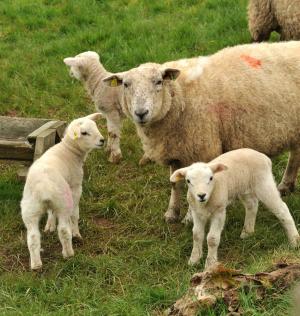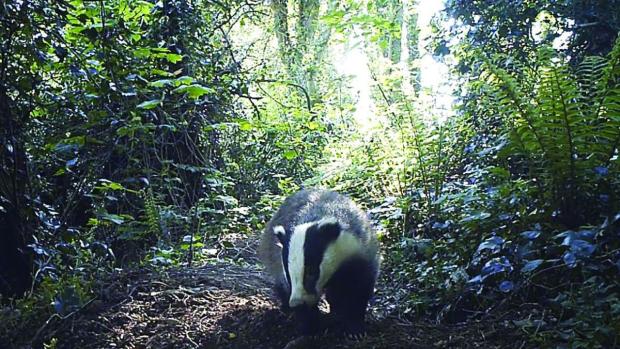AFBI research investigates frequency of badger/cattle contact
Date published:
A recently completed AFBI research project that aimed to determine the level of close range contact between badgers and cattle at pasture in Northern Ireland has found little evidence that the species interact with each other directly.

“Bovine tuberculosis is a major animal health disease in Northern Ireland that causes hardship to the farming community and has considerable cost implications for the public expenditure” said Dr Declan O’Mahony of the Agri-Food and Biosciences Institute (AFBI) who led the recent study.
Badgers have been implicated in the transmission of bovine tuberculosis to cattle yet the mechanism(s) by which this may occur are poorly understood. “There are many potential routes for the transmission of bovine tuberculosis between species that include direct close range contact between cattle and badgers or indirect contact at setts, latrines, water troughs or in farmyards. We need quantifiable data from scientific research on which routes are most important so that we can develop mitigation strategies that minimise the potential for disease spread between badgers and cattle. This could in turn lead to healthier badger and cattle populations” said Dr O’Mahony.
Northern Ireland is committed to the eradication of bovine tuberculosis and the Department of Agriculture and Rural Development (DARD) has a comprehensive programme of testing, controls and research into this disease that supports this objective.

Using recently developed proximity collars that allow close range interactions between animals to be determined, Dr O’Mahony and his team provided the first data on how often badgers and cattle come within close contact at pasture in Northern Ireland.
“Proximity collars are a new and exciting technology, which allow a hitherto unprecedented level of data to be obtained on interactions between animals. Each collar has a unique identity and constantly emits an electronic signal. When two collars come within a specified distance, both collars record that they have ‘met’ and the collar numbers, date, time and length of contact is recorded. The details can then be downloaded from collars when returned from animals”.
These collars collected information on how often cattle and badgers came into contact and also recorded how often collared cattle within herds and collared badgers within social groups, came into contact.
The team put collars on badgers and cattle in a 1,350 hectare study area in Co. Down during a 5 month period and then collected the collars and downloaded the information so that the amount of close range (less than 2m) contact could be determined.
“Local farmers were instrumental to this study as they gave us permission to put collars on cattle and also assisted in the process. Without their help we would not have been able to undertake this study and we are very grateful to them”, added Dr O’Mahony.
In total, over 376,000 interactions were recorded on the proximity collars that were deployed, the majority of which were contacts between cattle. “It was an exciting time for us” said Dr O’Mahony. “This was the first study of its kind anywhere on the island of Ireland and data we obtained was unique and could be very important in terms of the management and eradication of bovine tuberculosis”.
The results were perhaps a bit surprising. “The study found that all collared cattle interacted with each other within the different herds studied and also that all collared badgers interacted with each other in their different social groups”. However, at no time were badgers and cattle recorded as coming within direct close-range contact (< 2m) with each other during the study.
“Whilst this might seem to be an unlikely result, it is supported by an increasing body of evidence that suggests close-range contact between badgers and cattle may not be a common occurrence” commented Dr O’Mahony. “If you think about it badgers are relatively small animals that weigh 10-15kg at most, whereas cattle are very large and gregarious animals that can be very inquisitive. Such size and behaviour differences may lead to very little direct contact between the species when cattle are grazing at pasture”.
This study occurred in one area of Northern Ireland over a relatively short period of time. Whilst direct interactions between cattle and badgers were not recorded in this study that does of course not necessarily mean that interactions do not occur. It does support the increasing evidence that such contact is likely to be at a very low level, but still may be important if infected animals are involved.
A copy of the project report is available on the DARDNI website at www.dardni.gov.uk/articles/interactions-between-badgers-and-cattle-rural-environment
Notes to editors:
The Agri-Food and Biosciences Institute (AFBI), is a leading provider of scientific research and services to government, non-governmental and commercial organisationsThis project was funded by the TB/Brucellosis Policy Branch of the Department of Agriculture and Rural Development.AFBI carries out high-quality technology research and development, statutory, analytical, and diagnostic testing functions for DARD and other Government departments, public bodies and commercial companies.AFBI's Vision is “Scientific excellence in Northern Ireland … serving the world”.All media enquiries to AFBI Press Office Images supplied are subject to copyright